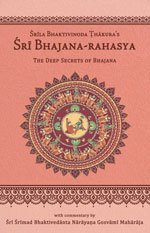Bhajana-Rahasya
by Srila Bhaktivinoda Thakura Mahasaya | 2010 | 123,965 words
The Bhajana-rahasya Text 8, English translation, including commentary (vritti). The Bhajana-rahasya is a compilation of verses describing the mercy of the eight pairs of names (Yugala-nama) of the Maha-mantra. This is text 8 belonging to the chapter “Dvitiya-yama-sadhana (Pratah-kaliya-bhajana)” representing the first six dandas of the morning: approximately 6.00 a.m.–8.30 a.m.
Text 8
Svarūpa-bhrama is of four types, as stated in the Āmnāya-sūtravyākhyā:
स्व-तत्त्वे पर-तत्त्वे च साध्य-साधन-तत्त्वयोः
विरोधि-विषये चैव तत्त्व-भ्रमश् चतुर्-विधःsva-tattve para-tattve ca sādhya-sādhana-tattvayoḥ
virodhi-viṣaye caiva tattva-bhramaś catur-vidhaḥThe conditioned living entity is subject to four kinds of bhrama, or illusion: (1) jīva-svarūpa-bhrama, (2) para-tattva-bhrama, (3) sādhya-sādhana-tattva-bhrama and (4) bhajana-virodhiviṣaya-bhrama.
तत्त्व-भ्रम चतुष्टय बडै विषम
स्वीय-तत्त्वे भ्रम आर कृष्ण-तत्त्वे भ्रमtattva-bhrama catuṣṭaya baḍai viṣama
svīya-tattve bhrama āra kṛṣṇa-tattve bhramaसाध्य-साधनेते भ्रम, विरोधी विषये
चारि-विध तत्त्व-भ्रम बद्ध-जीव-चयेsādhya-sādhanete bhrama, virodhī viṣaye
cāri-vidha tattva-bhrama baddha-jīva-caye
Commentary: Bhajana-rahasya-vṛtti:
Jīva-svarūpa-bhrama–The living entity cannot realise his own transcendental nature due to ignorance of it. He has forgotten his real svarūpa that he is the servant of Śrī Kṛṣṇa, because he thinks himself to be the enjoyer.
Para-tattva-bhrama–Who is para-tattva, the Absolute Truth? Not knowing this, the living entity becomes illusioned. Sometimes he worships Śiva, sometimes Brahmā and sometimes another demigod or goddess. The inability to correctly ascertain the Absolute Truth is called para-tattva-bhrama.
Sādhya-sādhana-bhrama–According to the scriptures, kṛṣṇaprema is the only goal (sādhya) and bhakti the only practice (sādhana ). The conditioned living entity, however, is unable to decide which is his goal among sense enjoyment, liberation and kṛṣṇaprema, and which is his practice among karma, jñāna and bhakti. This is sādhya-sādhana-bhrama, illusion about the goal and the process to attain it. If one cannot ascertain the goal, it is not possible to determine the practice, and without the practice it is not possible to attain the goal. It is only by the mercy of Vaiṣṇavas that one can obtain the fortune to understand that bhakti is the only auspicious spiritual practice, and prema is the only aim and object. Prema is of two kinds: aiśvarya-para (full of opulence) and mādhurya-para (full of sweetness). The ācāryas have determined that the topmost goal is sweet, loving service to Śrī Rādhā-Kṛṣṇa under the guidance of the vraja-gopīs.
Bhajana-virodhi-viṣaya-bhrama–Doctrines other than Vaiṣṇavism oppose bhajana and cause bewilderment (virodhi-bhrama ). This especially applies to impersonalism (māyāvāda), which contaminates the heart and thus renders the living entity unable to discriminate.
